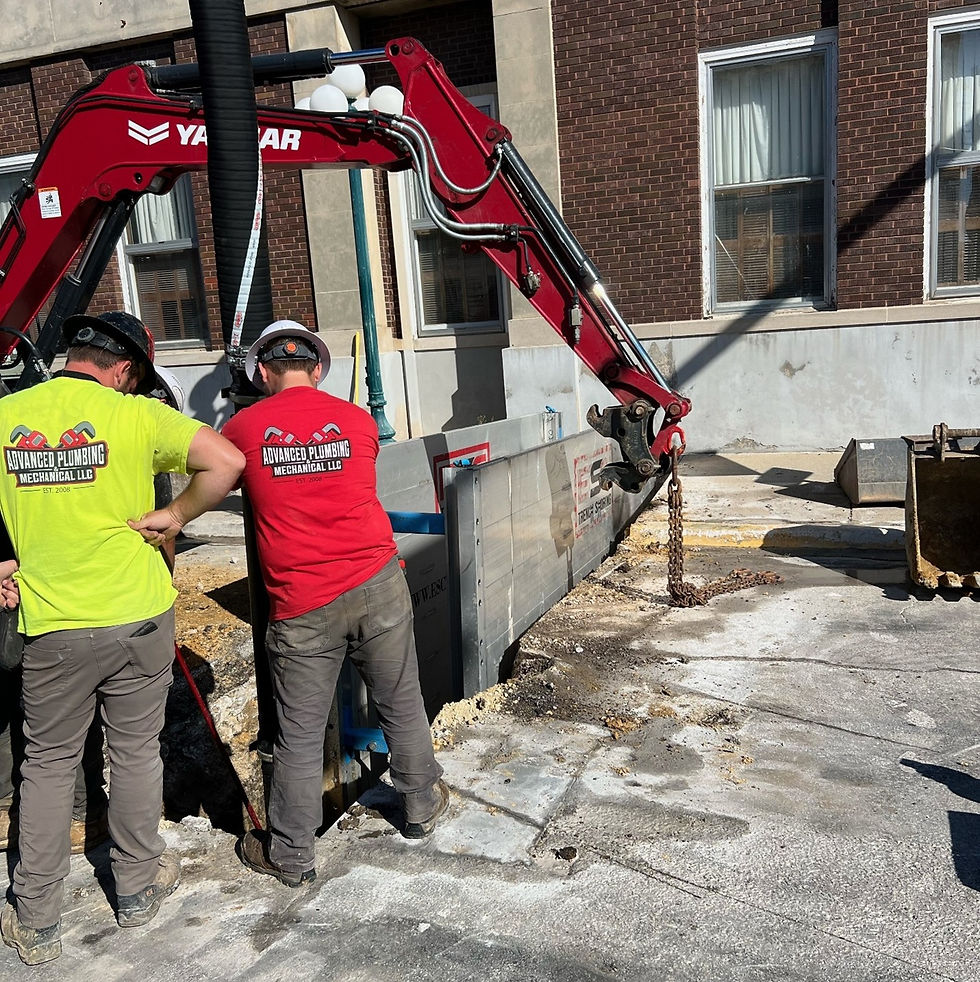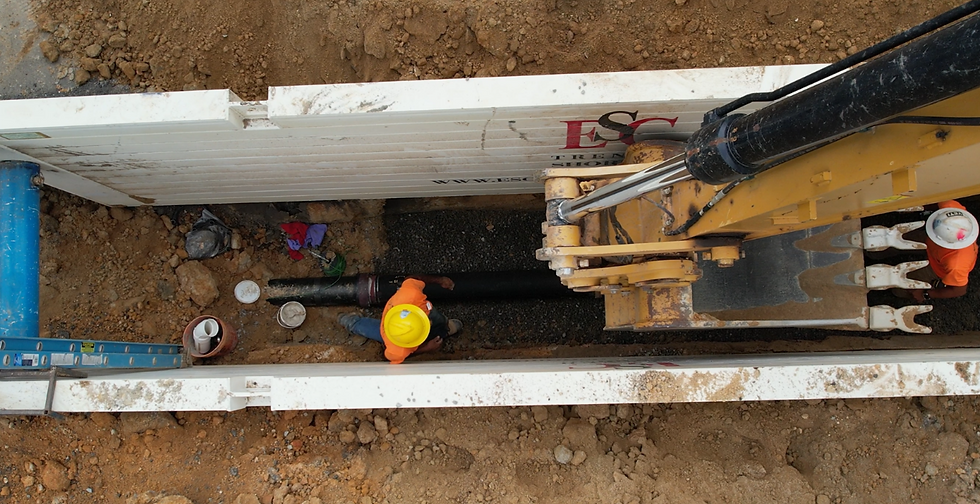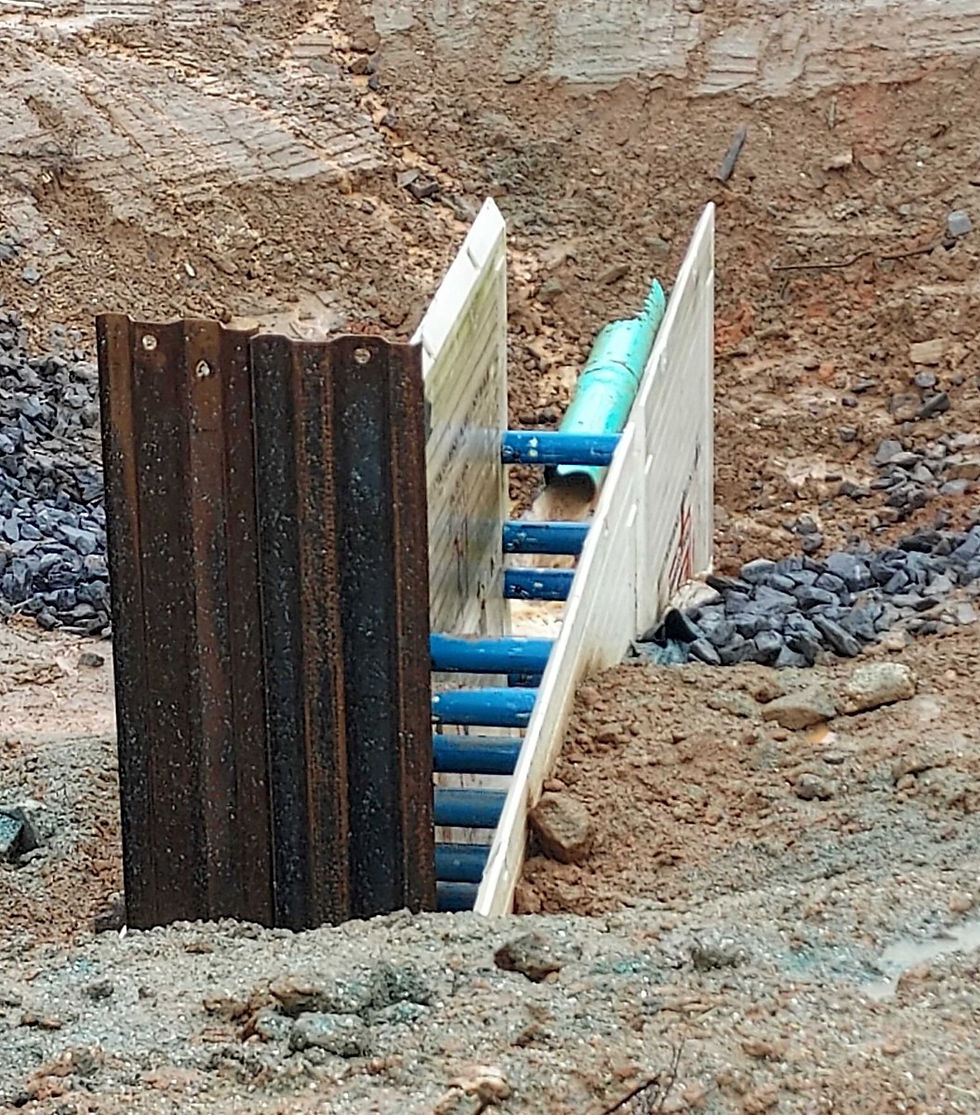ESC Trench Box Safety Guide: Protecting Your Crew Below Ground
- Marketing Department

- Jul 26, 2025
- 7 min read
In the demanding world of construction, trenching is a common yet high-risk activity. Whether you're installing pipelines, laying utilities, or repairing underground infrastructure, working below ground exposes crews to one of the deadliest hazards in the industry: cave-ins.
ESC Trench Shoring Inc. is proud to be a leading provider of trench protection solutions, not just with equipment, but with their expertise, training, and standards that define what safety looks like in real-world excavation sites. This guide explores everything you need to know about trench box safety, how ESC’s certified systems work, and how to protect workers at every depth and every level of experience.
What Is a Trench Box and Why Does It Matter?
A trench box — also known as a trench shield — is a protective system designed to safeguard workers inside excavations by resisting the lateral pressure of surrounding soil. It does not prevent soil movement entirely, but it creates a stable workspace inside the trench.
Each standard trench box consists of:
This two-sided configuration is lowered into position by heavy machinery such as excavators or backhoes. Workers can then enter the trench and perform tasks within the protected space. These systems are essential for preventing injuries caused by cave-ins, soil shifts, or falling debris.
By employing ESC trench boxes correctly, teams can increase productivity while reducing the chance of site delays due to accidents or compliance violations.
How Trench Boxes Work — The Basics of Structural Protection
As trenches deepen, earth pressure begins to act aggressively on the vertical walls. Trench boxes are designed to absorb and redistribute that pressure. Here's how:
Side Panels: Made from high-tensile steel or aluminum, panels take on the brunt of the lateral load from the soil.
Spreaders: These connect the panels and hold them apart at a fixed width, transferring force from one side to the other.
Load Distribution: Instead of collapsing inward, the pressure is pushed into the rigid structure of the box, maintaining a stable environment for workers.
These systems are not designed to shore up the trench walls themselves — rather, they shield workers from the dangers of a collapse. For projects with unstable soil or additional external pressure, engineered shoring or sloping should accompany the trench box setup.
ESC’s Trench Shield Series: Engineered for Excellence
At ESC, trench safety begins with smart design and rigorous engineering. Our Trench Shield Series is a fully developed excavation support system designed for trenches up to 40 feet deep, giving contractors robust protection without compromising performance.
Key Features:
Heavy-duty panels fabricated from high-grade materials
Adjustable spreaders for variable trench widths
Third-party certifications ensuring compliance with national and international standards
Fully compliant designs aligned with NAXSA (North American Excavation Shoring Association) guidelines
Each shield is independently certified by professional engineers, verifying its strength, design limits, and proper use under real trenching conditions. ESC Trench Shoring goes the extra mile to ensure each unit delivers not just durability, but confidence at every jobsite.
Trenching Safety Basics: Know Before You Dig
OSHA mandates protective systems for all trenches deeper than 5 feet, and for those exceeding 20 feet, the setup must be reviewed or designed by a qualified engineer. ESC makes this process easier by offering tabulated data, assembly instructions, and ongoing support for crews at any level.
Core Safety Practices:
Inspect trench boxes and equipment daily
Keep spoil piles and machinery at least 2 feet from trench edges
Use high-visibility clothing and personal protective equipment (PPE)
Map and mark underground utilities before digging
Always work under the guidance of a trained Competent Person
Failure to implement these measures could lead to misuse and may cause serious injuries, delays, fines, or worse. ESC not only supplies compliant trench shields but also actively works with teams to train and support the correct usage from day one.
For detailed regulations, visit OSHA’s Trenching and Excavation Safety page.
The Role of a Competent Person — On Every ESC-Supported Site
According to OSHA, a Competent Person is someone who can identify trench hazards and is authorized to take immediate corrective action. This role is critical to trench safety and must be present on any excavation deeper than 5 feet.
Responsibilities Include:
Classifying soil types and determining stability (Type A, B, C)
Inspecting trench boxes, shoring, and protective equipment
Monitoring environmental changes (rain, vibration, excavation shifts)
Designing and approving access ramps or exits
Ensuring proper water removal and trench drainage
No trench box should be installed, stacked, or repositioned without the supervision of a Competent Person. ESC supports supervisors with checklists, guidelines, and training tools to help meet this requirement with confidence.
How to Use Trench Boxes Safely: Eight Expert Tips
Having a trench box on site is only half the battle — using it correctly is essential. Here are eight critical rules every crew should follow:
Know the Purpose
Trench boxes protect workers, not trench walls. If wall collapse is a concern, combine boxes with engineered shoring.
Respect the Ratings
Never exceed the manufacturer’s depth rating. Always use boxes as specified in ESC’s tabulated data.
Keep the Bottom Close
Trench boxes should sit no more than 2 feet above the trench floor. A wider gap increases the risk of a cave-in from below.
Protect the Top Edge
In sloped trenches, elevate the top of the box at least 18 inches above the soil grade to prevent debris entry.
Inspect Before Entry
Bent spreaders, damaged panels, or misuse (like lifting from the spreader pipe) require immediate repair or replacement.
End Panel Placement Matters
Never rest end panels directly on spreader pipes. Always follow engineering specs for proper support and load transfer.
Stack Boxes Safely
If stack vertically, align and pin each unit carefully. Thinner boxes typically go on top of thicker ones.
Backfill Void Spaces
The gap between the trench wall and shield must be filled to prevent lateral movement and shifting during excavation.
ESC trains crews to follow these practices with visual guides, step-by-step field instructions, and customizable safety
ESC’s Safety Standards — Backed by NAXSA
Safety goes beyond the equipment itself. ESC ensures every trenching operation follows best practices by:
Requiring soil classification by a qualified Competent Person
Enforcing ESC-specific assembly procedures for consistent results
Adhering to NAXSA safety standards and regulations at every stage
As a proud member of NAXSA, ESC encourages clients to reference NAXSA-approved safety guidelines when planning or executing trench operations. These standards represent the best in excavation safety — and ESC is proud to help uphold them.
Trench Safety for New Construction Workers
Joining a construction crew for the first time? Trenching work comes with serious risks, and that’s why safety should be your top priority.
What Every New Worker Should Know:
Learn to identify unstable soil conditions, bulges, or gas leaks
Use and understand trench boxes, sloping, and shielding systems
Respect the authority of the Competent Person — ask questions
Stay clear of suspended loads, wear proper PPE, and follow site rules
Speak up if something feels unsafe — your voice matters
ESC supports new workers with briefings, training sessions, visual checklists, and simplified guidance that turns complex systems into understandable procedures.
Real-World Applications — Where ESC Shields Make a Difference
ESC Trench Shoring’s trench boxes aren’t confined to one type of jobsite. Our clients span industries like utility installation, oil and gas, water and sewer, infrastructure development, and emergency repair services. Whether you're digging on rural farmland or navigating a tight urban corridor, our systems scale to meet the terrain and task.
For example:
In municipal sewer upgrades, ESC trench shields provide fast, repeatable setup in dense neighborhoods, minimizing downtime and traffic disruption.
In pipeline construction, deeper excavations are common. ESC’s engineered shields paired with sloping or benching methods help meet environmental and federal standards.
In disaster recovery zones, our rapid-deployment boxes help restore critical services while protecting crews under pressure.
Each solution is backed by ESC’s consulting team to help interpret soil data, match equipment with trench requirements, and plan compliant, efficient excavation strategies
ESC Extended Support: From Planning to Post-Project
ESC’s role doesn’t stop once the shield hits the ground. Our mission is to empower contractors with full-cycle support across:
Project planning: Need help interpreting soil classifications or trench depth requirements? We offer expert consultations.
Product selection: Choose the right shield dimensions, panel thickness, and spreader combinations.
Field troubleshooting: Call our support team to resolve on-site concerns or clarify setup procedures.
Training: We provide documentation and live walkthroughs for foremen and site supervisors.
Our team is made up of engineers, safety experts, and product specialists who understand the real pressures of trench work and how to solve them.
Why Choose ESC Trench Shoring Inc.?
There are plenty of trench protection options out there, so why ESC?
Trusted Certification
All ESC trench shields are certified by third-party professional engineers, not just internally approved.
Global Standards Compliance
We design for both national and international codes, including OSHA, AS/NZS, and Eurocode standards.
NAXSA Membership
ESC is a committed member of the North American Excavation Shoring Association, helping advance safe trenching practices across industries.
Customizable Systems
ESC offers fully customizable trench shield systems — from double-wall designs to enhanced depth ratings — engineered to meet your specific project requirements.
Ready to Dig Smarter, Safer, and Stronger?
📞 Speak with our trench safety advisors today +1 (980) 892-2486 / +1 (980) 689 4389
🌐 Visit www.escstrenchshoring.com to explore product lines and download technical data
📩 Reach out via our online contact form to request a quote, schedule a consultation, or access ESC’s full safety toolkit.
Let’s build with care. Let’s dig with confidence. Let’s protect every crew — one trench at a time.





















